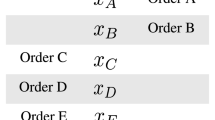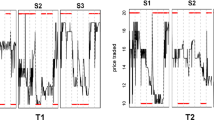Abstract
We study the influence of large traders in the stock market in the presence of a fringe of marginal “noise traders”. We formulate a trade model relating stock price to the demand strategies of these traders who wish to maximize their payoffs. Using the Nash equilibrium concept, we compute the optimal value functions for the large traders and study the stability of the state process (log price) under equilibrium strategies of the large traders. In the process, we propose two measures. The first one is to measure the big traders’ total faith on the market’s valuation (φ 0), and the second one is to measure the big traders’ interaction between themselves (φ 1). We discuss what values of the measures might indicate a collusion of the big traders to corner the market for their benefit and illustrate this with numerical examples. We also illustrate, with diagrams, the historical and instantaneous correlation among the value processes for these large traders to highlight certain interesting features that influence the market.
Similar content being viewed by others
References
Basak GK (1991) A class of limit theorems for singular diffusions. J Multivar Anal 39:44–59
Basak GK, Bhattacharya RN (1992) Stability in distribution for a class of singular diffusions. Ann Probab 20:312–321
Basak GK, Ghosh MK, Mukherjee D (2009) Equilibrium and stability of a stock market game with big traders. Differ Equ Dyn Syst 17(3):283–299
Berkelaar AB, Kouwenberg R, Post T (2004) Optimal portfolio choice under loss aversion. Rev Econ Stat 86(4):973–987
Bollerslev T, Chou RY, Kroner KF (1992) ARCH modeling in finance: a review of the theory and empirical evidence. J Econom 52:5–59
Borkar VS (1989) Optimal control of diffusion processes. Pitman research notes in mathematics. Longman Scientific and Technical, Harlow
Borkar VS, Ghosh MK (1992) Stochastic differential games: an occupation measure based approach. J Optim Theory Appl 73:359–385. Errata corrige, ibid, 88:251–252 (1996)
Buckdahn R, Cardaliaguet P, Rainer C (2004) Nash equilibrium payoffs for nonzero-sum stochastic differential games. Mimeo, Universite de Bretagne Occidentale
Chan LKC, Lakonishok J (1993) Institutional trades and intraday stock price behavior. J Financ Econ 33(2):173–199
Chan LKC, Lakonishok J (1995) The behavior of stock prices around institutional trades. J Finance 50(4):1147–1174
Engle RF (1982) Autoregressive conditional heteroskedasticity with estimates of the variance of UK inflation. Econometrica 50:987–1008
Friedman A (1976) Stochastic differential equations, vol 2. Academic Press, New York
Gokarn S (1996) Indian capital market reforms, 1992–96, an assessment. Economic and Political Weekly, April 13, 1996, pp 956–961
Heston SL (1993) A closed-form solution for options with stochastic volatility with applications to bond and currency options. Rev Financ Stud 6:327–343
Jin H, Zhou X (2008) Behavioral portfolio selection in continuous time. Math Finance 18:385–426
Jin H, Zhou X (2009) Greed, leverage, and potential losses: an application of portfolio choice under prospect theory. SSRN eLibrary
Jin H, Zhou X (2011) Greed, leverage, and potential losses: a prospect theory perspective. SSRN eLibrary, January
Jin H, Zhang S, Zhou X (2010) Behavioral portfolio selection with loss control. SSRN eLibrary, February
Kakati M (1999) Price performance of initial public offerings. Int J Dev Bank 17(2):59–75
Keim DB, Madhavan A (1995) Anatomy of the trading process: empirical evidence on the motivation for and execution of institutional equity trades. J Financ Econ 37:371–398
Keim DB, Madhavan A (1996) The upstairs market for large-block transactions: analysis and measurement of price effects. Rev Financ Stud 9:1–36
Keim DB, Madhavan A (1997) Transaction costs and investment style: an inter-exchange analysis of institutional equity trades. J Financ Econ 3:265–292
Krawczyk JB (2005) Numerical solutions to lump-sum pension problems that can yield left-skewed fund return distributions. In: Deissenburg C, Hartl RF (eds) Optimal control and dynamic games. Advances in computational management science, vol 7. Springer, New York, pp 155–176. Chap 10
Krawczyk JB (2008) On loss-avoiding payoff distribution in a dynamic portfolio management problem. J Risk Finance 9(2):151–172
Madhusoodanan TP (1997) Risk and return: a new look at the Indian stock market. Finance India XI(2):285–304
Nelson DB (1996) Asymptotically optimal smoothing with ARCH models. Econometrica 64:561–573
Nelson DB, Foster DP (1994) Asymptotic filtering theory for univariate ARCH models. Econometrica 62:1–41
Oksendal B (2003) Stochastic differential equations. Springer, Heidelberg
Tirole J (1995) The theory of industrial organisation. MIT Press, Cambridge
Tversky A, Kahneman D (1992) Advances in prospect theory: cumulative representation of uncertainty. J Risk Uncertain 5(4):297–323
Varian HR (1992) Microeconomic analysis, 3rd edn. WW Norton, New York
Author information
Authors and Affiliations
Corresponding author
Additional information
We would like to thank many patient readers and audiences of several international conferences for their helpful comments which helped us to improve the manuscript. We would also like to thank one of our former students, Subhadip Mitra for his numerical work regarding payoff functions during his Masters’ project.
The work of G.K. Basak is supported in part by an internal research grant from ISI.
The work of M.K. Ghosh was supported in part by a grant from UGC through DSA-SAP Phase IV.
Rights and permissions
About this article
Cite this article
Basak, G.K., Ghosh, M.K. & Mukherjee, D. Influence of Big Traders on the Stock Market: Theory and Simulation. Dyn Games Appl 1, 220–252 (2011). https://doi.org/10.1007/s13235-011-0011-x
Published:
Issue Date:
DOI: https://doi.org/10.1007/s13235-011-0011-x




